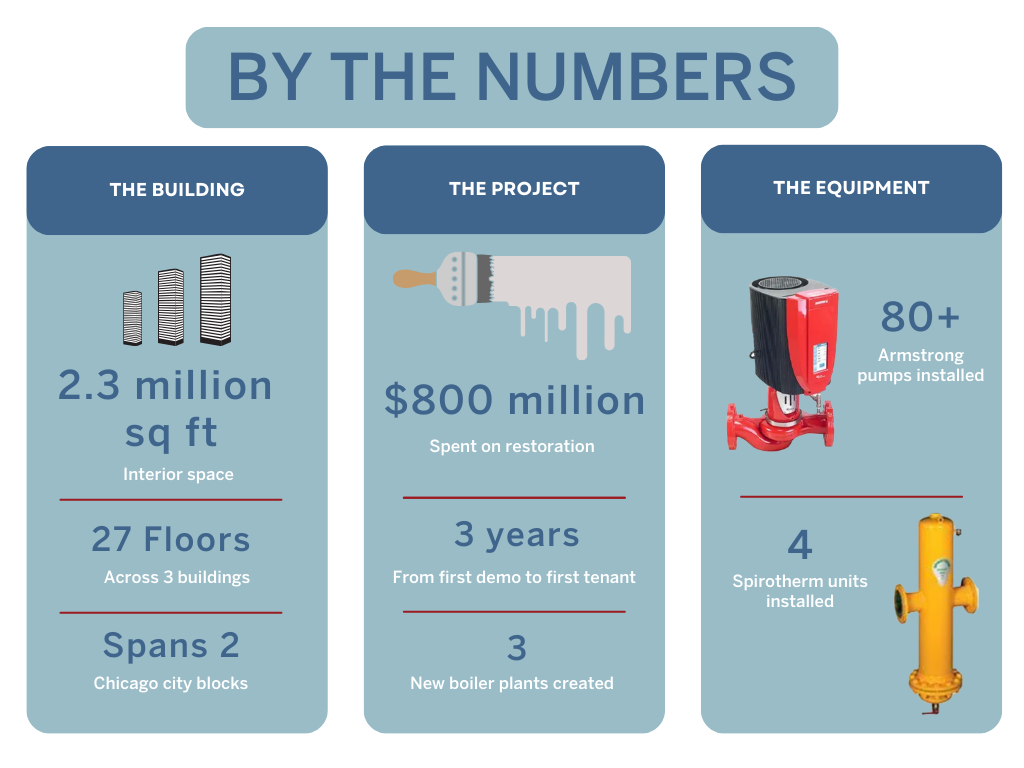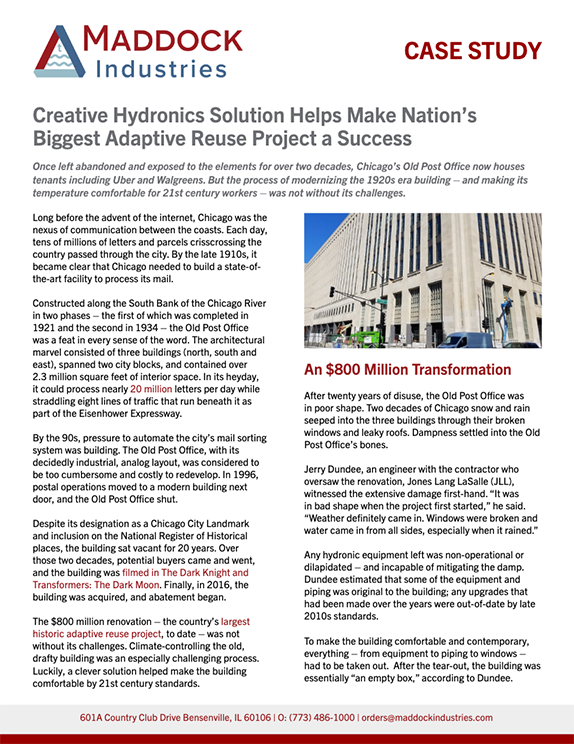Once left abandoned and exposed to the elements for over two decades, Chicago’s Old Post Office now houses tenants including Uber and Walgreens. But the process of modernizing the 1920s era building – and making its temperature comfortable for 21st century workers – was not without its challenges.
Long before the advent of the internet, Chicago was the nexus of communication between the coasts. Each day, tens of millions of letters and parcels crisscrossing the country passed through the city. By the late 1910s, it became clear that Chicago needed to build a state-of-the-art facility to process its mail.
Constructed along the South Bank of the Chicago River in two phases – the first of which was completed in 1921 and the second in 1934 – the Old Post Office was a feat in every sense of the word. The architectural marvel consisted of three buildings (north, south and east), spanned two city blocks, and contained over 2.3 million square feet of interior space. In its heyday, it could process nearly 20 million letters per day while straddling eight lines of traffic that run beneath it as part of the Eisenhower Expressway.
By the 90s, pressure to automate the city’s mail sorting system was building. The Old Post Office, with its decidedly industrial, analog layout, was considered to be too cumbersome and costly to redevelop. In 1996, postal operations moved to a modern building next door, and the Old Post Office shut.
Despite its designation as a Chicago City Landmark and inclusion on the National Register of Historical places, the building sat vacant for 20 years. Over those two decades, potential buyers came and went, and the building was filmed in The Dark Knight and Transformers: The Dark Moon. Finally, in 2016, the building was acquired, and abatement began.
The $800 million renovation – the country’s largest historic adaptive reuse project, to date – was not without its challenges. Climate-controlling the old, drafty building was an especially challenging process. Luckily, a clever solution helped make the building comfortable by 21st century standards.
An $800 Million Transformation
After twenty years of disuse, the Old Post Office was in poor shape. Two decades of Chicago snow and rain seeped into the three buildings through their broken windows and leaky roofs. Dampness settled into the Old Post Office’s bones.
Jerry Dundee, an engineer with the contractor who oversaw the renovation, Jones Lang LaSalle (JLL), witnessed the extensive damage first-hand. “It was in bad shape when the project first started,” he said. “Weather definitely came in. Windows were broken and water came in from all sides, especially when it rained.”
Any hydronic equipment left was non-operational or dilapidated – and incapable of mitigating the damp. Dundee estimated that some of the equipment and piping was original to the building; any upgrades that had been made over the years were out-of-date by late 2010s standards.
To make the building comfortable and contemporary, everything – from equipment to piping to windows – had to be taken out. After the tear-out, the building was essentially “an empty box,” according to Dundee.
While abatement was underway, the engineering team started specifying the new heating and cooling system. They took the square footage, size and direction of each unit across all three buildings into account to determine which hydronics systems would be needed to maintain comfortable temperatures throughout the Old Post Office – regardless of the season or time of day.
McGuire Engineers was brought in to help plot the design of the boiler plants and pump systems; Maddock Industries assisted with ideas and selections. After plans were finalized, set-up commenced. By the end of the project, Maddock had provided, and F.E. Moran had installed, over 80 Armstrong pumps – most of which were Design Envelope 4300s – and four Spirotherm units, to help the pumps run more efficiently.
21st Century Climatization in 1920s Bones
Retrofitting the enormous historic building with a modern heating and cooling system was no simple task. To add to the pressure, the timeline to get the Old Post Office’s temperature just right was tight – the first tenant’s lease started in 2019. That meant there was little time for trial and error.
While each of the three buildings posed unique challenges when it came to heating and cooling, the structure of the north building made the hydronics system installation particularly tricky. At 12 floors, the north building is the tallest of the three structures. Those 12 floors are narrower and more compact than those in the south and east – which meant McGuire Engineers, F.E. Moran and Maddock had limited space to work with.
Per the hydronics plan, each floor in the north building would have its own loop of chilled water and two tertiary Armstrong pumps. The size of the spaces dedicated to house the pumps was essentially that of “an old coat closet,” according to Michael Moxon, Maddock’s VP of engineering.
The ultra-constrained footprint of the pump rooms meant there wasn’t sufficient space to install check valves – which help prevent water from flowing backwards. Once the pumps were installed, the absence of check valves was quickly apparent: water was backflowing and short-circuiting the system. Unfortunately, nothing could be done to change the structure or layout of the pump rooms – Maddock sales engineers simply had to make the space work. They needed a creative solution.
Luckily, coming up with inventive solutions for tough problems is where Maddock’s hydronics experts excel. To stop the water from backflowing, the team devised and implemented a solution that involves running both pumps simultaneously – one at minimum speed and the other at the system’s desired speed.
The result? No more short-circuiting – and perfect temperature control throughout the north building. “[The team at] Maddock did a lot of work to make sure everything was running smoothly,” said Dundee.

Iconic Historic Gem, Modern Comfort
Renovations wrapped in early 2019, just before the first tenant’s lease began. “Watching the transition from what it was to what it is was amazing,” said Dundee.
Now, the Old Post Office’s tenants include Uber, Walgreens, PepsiCo, Cisco Systems, CBOE, and others. Despite evolving attitudes about in-office work, nearly every office in the building is leased. The Old Post Office also holds multiple event spaces, a food hall, and gym – all perfectly temperature controlled.
It’s an outcome that wouldn’t have been possible without the work of Maddock’s hydronics experts. Whenever Dundee and his team had questions, Maddock was “good about getting out there, looking into [issues], and resolving them.”
“Their team comes out to troubleshoot anything,” he added. “I would definitely recommend them.”
About Maddock Industries
Engineers, mechanical contractors and building owners needing a hydronics partner have relied on Maddock Industries since 1971. The Maddock hydronics experts will help you identify, source, install, and maintain pumps, boilers, valves, and other equipment you need with recommendations for how to maximize space, harness new technology, minimize maintenance costs, and increase profitability in commercial construction projects. Maddock represents Armstrong pumps, RBI water heaters, Garlock Link-Seal, Spirotherm air and dirt separators, Whalen fan coils and water source heat pumps, and more. Maddock specializes in high rises, K-12 schools, colleges, universities, hospitals, government buildings, and food processing plants. More: https://maddockindustries.com
About Armstrong Pumps
Armstrong Design Envelope inline pumps include integrated intelligent controls for space-saving installation and superior energy performance. DE pumps save up to 75% in energy over comparable traditional constant speed or variable frequency operated pump installations. More: https://armstrongfluidtechnology.com
About Spirotherm
Spirotherm manufactures industry-leading, high-efficiency Spirovent coalescing type air elimination products, the extended line of Spirotherm dirt separators, and Spirovent Quad hydraulic separators used in low loss header designs – all of which feature a 20-year warranty. Sizes range from ¾” to 36” pipe, flows to over 30,000 GPM for residential, commercial, industrial, and institutional applications. As a wholly owned subsidiary of Spiro Enterprises, Spirotherm has developed and manufactured products that improve water quality in the industry since 1990. More: https://spirotherm.com

